Landblog Main
previous archive
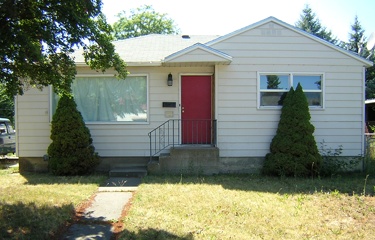 Welcome to the Houseblog -- 1 August 2011 -- Here's a photo of my house. This page explains why and how I bought it. It's in Spokane, Washington, built in 1951, around 1800 square feet counting the basement, on a 7000 square foot lot, half a mile from the river and two miles from downtown. My plan is live in it for a long time, and make it the house I want to live in. My philosophy is that there is no compromise between living value and resale value. Decide which one you're going for, and go all-out.
Welcome to the Houseblog -- 1 August 2011 -- Here's a photo of my house. This page explains why and how I bought it. It's in Spokane, Washington, built in 1951, around 1800 square feet counting the basement, on a 7000 square foot lot, half a mile from the river and two miles from downtown. My plan is live in it for a long time, and make it the house I want to live in. My philosophy is that there is no compromise between living value and resale value. Decide which one you're going for, and go all-out.Some of the stuff that's happened in my first two months as owner:
When you take possession of a HUD house, they have an insane policy where they unlock the house and then take the keys away! I could have got a locksmith to make new keys, but I preferred to buy new Schlage locks for all three doors. All the deadbolts needed surgery on the door frames to make them fit.
My first night sleeping there, I discovered something that never occurred to me when I was looking for houses. I'm less than ten blocks from railroad tracks, and a train whistle in the middle of the night is kind of loud if it's summer and you have the windows open.
I knew the plumbing didn't hold pressure, and it turned out there was a big leak from the outside front faucet. That was easily fixed with a washer, but the inside valve, for shutting it off in the winter, was also bad -- the place where the handle fit was totally stripped. So I replaced it with a brass ball valve... but reattaching the pipes to the outside is beyond my plumbing skill. The problem is that the 90 degree elbow has to face exactly the right way at exactly the right height to connect to a pipe through a hole in the side of the house, and it's damn hard to get it in that position without a leak somewhere. I've screwed and unscrewed the whole thing twenty times, experimenting with both brass and steel fittings and many different quantities of teflon tape, and finally I just replaced the ball valve with a cap. I don't expect to need a front faucet anyway.
There were more plumbing leaks: the backyard faucet, the upstairs shower, the hot water under the sink, and a major leak in the hot water valve to the dishwasher. Fixed them all, and plumbing is fun when it works! Also, past leaks from broken tiles in the upstairs shower, and from the dishwasher valve, had ruined some drywall on the basement ceiling. Tore it out.
That was only the start of drywall removal. I'm doing a major redesign of the inside of the house, and currently the spare basement room is half full of drywall to gradually go out in the garbage.
On the land I have a long-term visitor, Troy, who is also staying at the house some of the time. One day we tried to turn on the hot water heater for a shower, and it took us several hours to get the pilot light going. Finally, after pulling the whole mechanism out and taking it apart, I discovered that a bug had built a web inside the metal piece where the gas and air mix.
The oven doesn't work, and currently all cooking is being done on a plug-in induction burner, and a solar oven in the backyard.
There is no washer or dryer, but I've already bought two new chest freezers, an 8.8 cubic foot Kenmore to go in the basement as an actual freezer, and a 14.8 cubic foot GE for the kitchen, converted to a chest fridge with this freezer temperature controller. Depending on room temperature and how much it's used, it's averaging 15-20 watts.
Outside, I'm letting the grass and weeds turn brown, and I've dug up a few square feet to plant four tomatoes. The soil is ancient river bottom, dark, but about half the volume is round rocks of all sizes. Getting rocks out of the whole yard is an enormous task that will take many years.
Houseblog: the Oven Job -- 25 August 2011 -- Most houses have the oven and stove as a single unit. In my house they were separate, with an electric four-burner stove on top of a cabinet, and an electric oven a few feet away built into some shelves. The stove worked, but it stuck out too far and made the kitchen smaller. That's for another post. The oven was in a good place, but it did not work. It was obvious why the bake element didn't work -- a few inches were completely burned away, with drops of metal underneath. I went to the local Reliable Parts store and bought a new one and installed it. It still didn't work, and I wasn't surprised, because the broil element also didn't work, for no apparent reason. A little red light by the switch came on, but no heat.
I suspected the thermostat, and opened up the guts of the oven to take a look. There was a wiring diagram on a piece of paper browned around the edges, like a treasure map. After I figured out how to read it, I checked some connections with a multimeter, and the thermostat was conducting the way it should. The broken connection was inside the four position switch (Off, Bake, Broil, and Time Bake). I opened up the switch and sure enough, one of the pieces of metal was discolored and easy to bend, and had bent itself so it wasn't connecting. I thought bending it back would be a temporary fix, and possibly dangerous. So I went looking for a new switch.
Most ovens have a model number written somewhere around the edge of the front opening. This is usually not quite the same as the model number you use to order parts. On this oven a tiny plate said "J KS06 0J4AD", but online the model is called a "JKS06*J4". More research revealed that the original part number for the switch was AP2023792, and the newer number for the same part was WB22X5134. The best price was $50 on eBay, until I found a strange site, pickmrappliance.com, that was selling it for less than $20.
This is my experience when one internet price is much lower than other internet prices: you will not have your money stolen, but you will also not get the item for that price. I heard nothing for a couple weeks, emailed the guy, heard nothing again, and then then sent another email canceling the order and asking for my money back. Finally he said he had trouble finding the part and sent me a check for a full refund. By now I was planning to totally rewire the oven, using a generic thermostat and a toggle switch for bake/broil/off. Then my brother-in-law offered to donate a newer, larger convection oven. The model number on the oven is "J TP17WOV2WW", but parts stores call it "JTP17WV2WW".
 This is the new oven, all installed. You can see that I had to cut away some of the frame to get it in there. Also I had to do some work under it. The old oven was resting on two 2x4's, on a thin piece of plywood, which was unsupported at one corner! Ten inches below this was a shelf made of a thicker piece of plywood. I removed the 2x4's to create enough vertical room for the larger oven, switched the two pieces of plywood so the stronger one supported the oven, did some sawing to make both shelves fit, and nailed in some scrap wood to support them better.
This is the new oven, all installed. You can see that I had to cut away some of the frame to get it in there. Also I had to do some work under it. The old oven was resting on two 2x4's, on a thin piece of plywood, which was unsupported at one corner! Ten inches below this was a shelf made of a thicker piece of plywood. I removed the 2x4's to create enough vertical room for the larger oven, switched the two pieces of plywood so the stronger one supported the oven, did some sawing to make both shelves fit, and nailed in some scrap wood to support them better.But before I did all that, I had to do some electrical work. In the photo, directly behind and to the right of where I'm standing, was the stove top. Coming up from the floor under it were two electrical cables. Never mind one of them, but the other came from a junction box on the ceiling of the basement, where it connected to a thick cable that came from a 50 amp breaker on the panel. Also connected to the thick cable was a cable going back to a junction box under the oven.
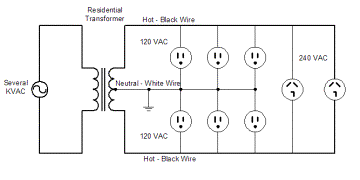 Did you ever wonder how the same circuit can have both 120 volt and 240 volt outlets? You can't get 240v by just putting two 120v wires in parallel, because that would add current but keep voltage the same. The way it really works is tricky, and I found this great image at the Radio Ether Blog. A house has three main wires: one ground, one 120v AC, and another 120v AC that is 180 degrees out of phase from the first. So when one hot wire is at +120, the other is at -120, and vice versa. To get 120v, you put your device between either hot wire and ground, and to get 240v, you put it between one hot wire and the other! And the panel is set up so that a double-width breaker taps into both hot lines. Black is hot, white is "neutral", and bare copper is ground (the difference is complicated). And when you have two hot wires running together, one is black and the other is red.
Did you ever wonder how the same circuit can have both 120 volt and 240 volt outlets? You can't get 240v by just putting two 120v wires in parallel, because that would add current but keep voltage the same. The way it really works is tricky, and I found this great image at the Radio Ether Blog. A house has three main wires: one ground, one 120v AC, and another 120v AC that is 180 degrees out of phase from the first. So when one hot wire is at +120, the other is at -120, and vice versa. To get 120v, you put your device between either hot wire and ground, and to get 240v, you put it between one hot wire and the other! And the panel is set up so that a double-width breaker taps into both hot lines. Black is hot, white is "neutral", and bare copper is ground (the difference is complicated). And when you have two hot wires running together, one is black and the other is red.If you have too many amps running through too thin a wire, the wire heats up and burns your house down. The 50 amp breaker was correctly connected to super-thick wires, probably 6 gauge (lower equals thicker). Originally, these must have gone to an oven-stove combo. But some previous owner kept the stove where it was and moved the oven, and used thinner 12 gauge wires to get the electricity over there. This is safe if the oven only draws 20 amps, but something could go wrong and make it draw more. And the wires in the snake (flexible metal conduit) to the oven were only 14 gauge. And in the new oven, the wires in the snake were only 16 gauge! So I replaced the 50 amp breaker with a 20 amp breaker, left the thick wire empty, and put in 12 gauge wires straight from the panel to a new junction box and then up to the oven. And there was one more trick. I was using scavenged wires that were black and white instead of black and red, so I got a red permanent marker and colored them.
 Houseblog: Roof Leak -- 6 September 2011 -- Last week we had the first big rainstorm since I took possession of the house. So I poked my head in the attic to see if there were any leaks in the roof, and saw this. You can see there's a wet spot on the underside of the roof, and there was a slow drip down to another wet spot in the insulation. (It's cellulose, not asbestos.) I put a pan under it and the next day I climbed on the roof. When I couldn't find any obvious holes, I climbed back down, went back in the house, climbed back to the attic, and used my hands and arms to carefully measure the location of the leak, using a roof vent as reference. It might have been a span over and three cubits down.
Houseblog: Roof Leak -- 6 September 2011 -- Last week we had the first big rainstorm since I took possession of the house. So I poked my head in the attic to see if there were any leaks in the roof, and saw this. You can see there's a wet spot on the underside of the roof, and there was a slow drip down to another wet spot in the insulation. (It's cellulose, not asbestos.) I put a pan under it and the next day I climbed on the roof. When I couldn't find any obvious holes, I climbed back down, went back in the house, climbed back to the attic, and used my hands and arms to carefully measure the location of the leak, using a roof vent as reference. It might have been a span over and three cubits down.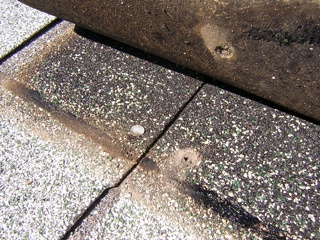 Then I went back on the roof and found a dimple on one of the shingles. Underneath I found this. Apparently one of the nails worked itself loose and fell out, and on the way it made a tiny hole in the shingle above it, conveniently matching the hole below.
Then I went back on the roof and found a dimple on one of the shingles. Underneath I found this. Apparently one of the nails worked itself loose and fell out, and on the way it made a tiny hole in the shingle above it, conveniently matching the hole below.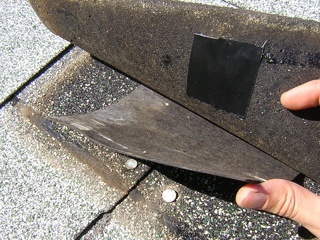 And here's how I fixed it. In a pile of house scraps, I found another roofing nail that had a rubber washer under the head, and pounded it in the hole. Then I duct taped the bottom of the shingle, and just to be extra safe, I stuck in a piece of tar paper.
And here's how I fixed it. In a pile of house scraps, I found another roofing nail that had a rubber washer under the head, and pounded it in the hole. Then I duct taped the bottom of the shingle, and just to be extra safe, I stuck in a piece of tar paper.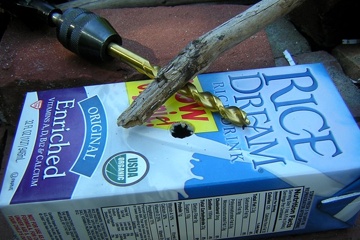 Landblog: Hut Roof Insulation -- 19 September 2011 -- I've done almost nothing on the land this year except this one little project, which was mostly done by Troy. The idea was to insulate the underside of the hut roof with a bunch of empty rice milk cartons. So, how do you attach cartons to the bottom of a piece of plywood? The normal way would be a bunch of toxic goop, but I wanted to do it with thumbtacks. This turned out to be difficult. Thumbtacks are made for cork board, not plywood. You need to drive the tack hard and straight. How can you do that from the inside of a carton?
Landblog: Hut Roof Insulation -- 19 September 2011 -- I've done almost nothing on the land this year except this one little project, which was mostly done by Troy. The idea was to insulate the underside of the hut roof with a bunch of empty rice milk cartons. So, how do you attach cartons to the bottom of a piece of plywood? The normal way would be a bunch of toxic goop, but I wanted to do it with thumbtacks. This turned out to be difficult. Thumbtacks are made for cork board, not plywood. You need to drive the tack hard and straight. How can you do that from the inside of a carton?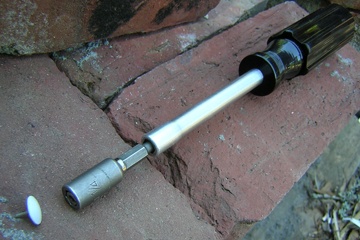 In the photo above you see step one. Using a 3/8 inch drill bit, which wasn't big enough, and then a stick to enlarge the hole, we made holes in a bunch of cartons. In this photo you see the tool for the next step: a hex driver with a magnetic hex driver bit stuck in it... and if you look closely, inside the magnetic hex hole is a coiled bit of thick steel wire, filed down to exactly fill the hole. This was necessary to bring the magnetism up to the tip to directly hold the thumbtack. Then it's just a matter of holding the carton on the roof, putting a tack on the end of the driver, fitting it through the hole, and using a mallet to pound the tack through the other side. Even with this tool, many of the tacks got bent instead of going in.
In the photo above you see step one. Using a 3/8 inch drill bit, which wasn't big enough, and then a stick to enlarge the hole, we made holes in a bunch of cartons. In this photo you see the tool for the next step: a hex driver with a magnetic hex driver bit stuck in it... and if you look closely, inside the magnetic hex hole is a coiled bit of thick steel wire, filed down to exactly fill the hole. This was necessary to bring the magnetism up to the tip to directly hold the thumbtack. Then it's just a matter of holding the carton on the roof, putting a tack on the end of the driver, fitting it through the hole, and using a mallet to pound the tack through the other side. Even with this tool, many of the tacks got bent instead of going in. And here you see the project mostly done. The holes are covered with blue painters tape, and we also used that to cover the holes on the ends of the carton where the rice milk came out. At this point we ran out of cartons, and I still have a few more to drink. Those strings between the beams were added by Troy to hold the next layer of insulation, which hasn't been decided yet. If I can't find a cheap source of raw sheep wool, I might use thrift store blankets.
And here you see the project mostly done. The holes are covered with blue painters tape, and we also used that to cover the holes on the ends of the carton where the rice milk came out. At this point we ran out of cartons, and I still have a few more to drink. Those strings between the beams were added by Troy to hold the next layer of insulation, which hasn't been decided yet. If I can't find a cheap source of raw sheep wool, I might use thrift store blankets.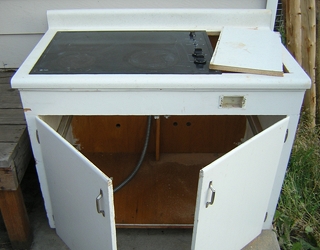 Houseblog: Compost Cabinet - 12 December 2011 - This is a project I did mostly in September and only now got around to making a post. In the first photo you can see the stove cabinet that I hauled out of the kitchen. Previous owners moved the oven to another place and made this thing to hold up the stovetop. It was shrinking the kitchen too much, so I removed it to replace it with something else that I'm still working on. But it occurred to me that this would make a good enclosure for compost. So I removed the stovetop, cut the rest of the top off, and then set them temporarily back on top for the photo.
Houseblog: Compost Cabinet - 12 December 2011 - This is a project I did mostly in September and only now got around to making a post. In the first photo you can see the stove cabinet that I hauled out of the kitchen. Previous owners moved the oven to another place and made this thing to hold up the stovetop. It was shrinking the kitchen too much, so I removed it to replace it with something else that I'm still working on. But it occurred to me that this would make a good enclosure for compost. So I removed the stovetop, cut the rest of the top off, and then set them temporarily back on top for the photo. If you use wood to hold compost, it will eventually rot. I used several tricks to delay this. First I coated all the interior exposed wood with expired flax seed oil. Flax oil is the same as linseed oil, but because it's food grade, I can safely get it all over my hands. I decided to do two chambers, and on the bottom of each I put an extra piece of plywood. All the wood I used was scrap wood that came with the house. The rest of the interior framing is to hold hardware cloth to keep the compost away from the walls, and I drilled a bunch of holes to let some air in.
If you use wood to hold compost, it will eventually rot. I used several tricks to delay this. First I coated all the interior exposed wood with expired flax seed oil. Flax oil is the same as linseed oil, but because it's food grade, I can safely get it all over my hands. I decided to do two chambers, and on the bottom of each I put an extra piece of plywood. All the wood I used was scrap wood that came with the house. The rest of the interior framing is to hold hardware cloth to keep the compost away from the walls, and I drilled a bunch of holes to let some air in.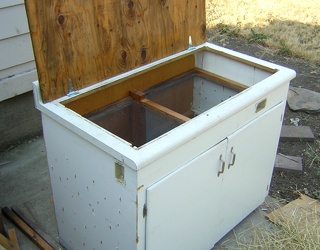 And here it is finished. Not shown are two more pieces of plywood to cover the front, behind the doors. They slide down from the top into notches, so to empty either side of the bin, I can just open the door and pull the gate up. One thing that did not go as expected: mice got in through the cracks around the hinges. I don't mind having mice in my compost, but this bin is for humanure, and I don't want them tracking it around. I eventually solved this by getting a cheap open-air bin for kitchen scraps. Another problem is that the whole thing is too small to hold even one person's poop (mixed with sawdust) until it's done composting. Not sure what I'm going to do about that, but at least it means there will be a lot of compost.
And here it is finished. Not shown are two more pieces of plywood to cover the front, behind the doors. They slide down from the top into notches, so to empty either side of the bin, I can just open the door and pull the gate up. One thing that did not go as expected: mice got in through the cracks around the hinges. I don't mind having mice in my compost, but this bin is for humanure, and I don't want them tracking it around. I eventually solved this by getting a cheap open-air bin for kitchen scraps. Another problem is that the whole thing is too small to hold even one person's poop (mixed with sawdust) until it's done composting. Not sure what I'm going to do about that, but at least it means there will be a lot of compost.